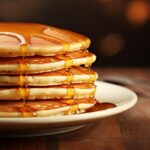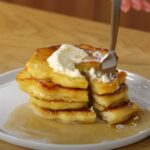Are you ready for the fluffiest and most delightful pancake experience ever? Well, get ready to have your taste buds dancing with joy because today, I’m going to share with you the ultimate pancake hack – making pancakes with a muffin mix!
Yes, you heard it right, we’re taking the classic pancake game to a whole new level of simplicity and deliciousness. Pancakes have become my favorite breakfast for sure, and this easy-peasy recipe helped me flip them like a pro in no time. Shall we start then?
The Basics of a Muffin Mix
Muffin mix is a versatile ingredient that can be used to make a variety of baked goods, including pancakes. The mix typically contains flour, sugar, leavening agents, and flavorings, which are all essential ingredients in pancake batter.
This means that you can use muffin mix as a shortcut when making pancakes, saving you the time and effort of measuring out the individual ingredients. The advantage of using muffin mix is that it comes in a variety of flavors, allowing you to easily add a twist to your pancakes.
Whether you prefer blueberry, chocolate chip, or banana nut, there’s a muffin mix out there for you. Plus, using muffin mix can save you time and effort, as you don’t have to measure out the dry ingredients. This makes it a great option for busy mornings when you want a delicious breakfast but you don’t have a lot of time to spare.
| Ingredient | Purpose |
|---|---|
| Flour | Provides structure for the muffins |
| Sugar | Adds sweetness |
| Baking Powder | A leavening agent that helps the muffins rise |
| Salt | Enhances the flavors of the other ingredients |
| Optional Flavorings | Adds specific flavors (e.g., fruit, chocolate, spices) |
| Oil or Butter | Adds moisture and richness |
| Dried or Fresh Eggs | Binds the ingredients together and helps the muffins rise |
Choosing the Right Mix
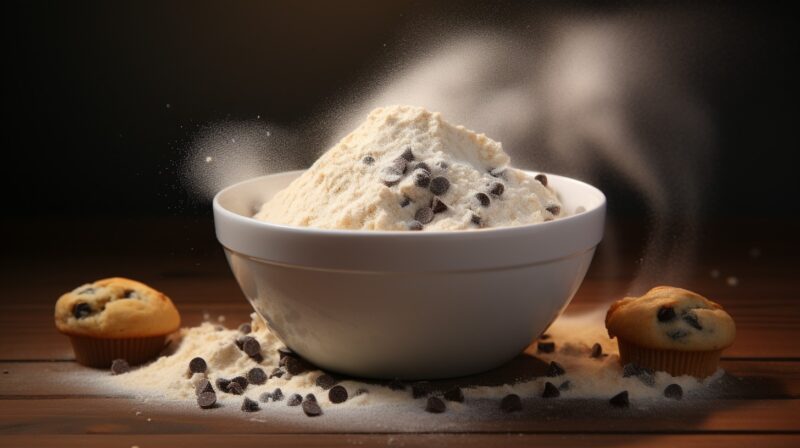
Consider the Flavor
When choosing a muffin mix for your pancakes, the first thing to consider is the flavor. The flavor of the mix will significantly influence the taste of your pancakes. For a classic pancake flavor, opt for a plain or vanilla muffin mix. If you want something more adventurous, try a flavored mix like blueberry or chocolate chip.
These mixes contain real fruit or chocolate chips, adding a burst of flavor to every bite of your pancakes. The flavor of the muffin mix will be the star of your pancakes, so choose a flavor that you and your family will enjoy.
Also, consider the toppings you plan to use. Some flavors may pair better with certain toppings than others. For example, a chocolate chip muffin mix would pair well with a dollop of whipped cream and a drizzle of chocolate sauce, while a blueberry muffin mix would go great with fresh blueberries and a sprinkle of powdered sugar.
Check the Ingredients
The next thing to consider is the ingredients in the muffin mix. Some mixes may contain ingredients that you don’t want in your pancakes, such as artificial flavors or preservatives. Look for a mix with ingredients that you recognize and feel comfortable eating.
This way, you can ensure that your pancakes are not only delicious but also made with quality ingredients. Also, check the sugar content of the mix. Some mixes can be quite sweet, which may not be to everyone’s liking.
If you prefer less sweet pancakes, opt for a mix with lower sugar content. Alternatively, you can balance out the sweetness of the mix by choosing less sweet toppings, such as fresh fruits or plain yogurt.
Preparing the Batter
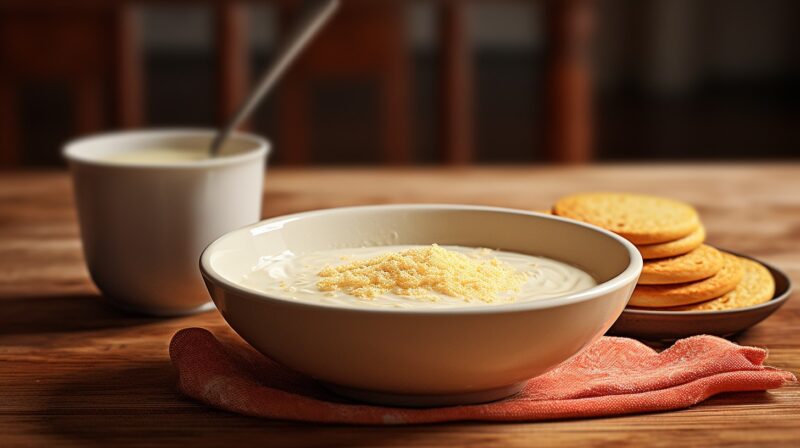
Mixing the Batter
Once you’ve chosen your muffin mix, it’s time to prepare the batter. The process is similar to making regular pancake batter. Start by combining the muffin mix with the wet ingredients, which typically include milk, eggs, and oil or butter.
The milk provides moisture, the eggs add structure and richness, and the oil or butter contributes to a tender texture and rich flavor. The key to a good pancake batter is not to overmix. Overmixing can lead to tough pancakes, as it develops the gluten in the flour. Mix just until the ingredients are combined, even if there are a few lumps left.
These lumps will disappear as the pancakes cook, and trying to eliminate them by mixing more can result in overdeveloped gluten and tough pancakes.
Adjusting the Consistency
The consistency of the batter can greatly affect the outcome of your pancakes. A batter that’s too thick will result in dense, heavy pancakes, while a batter that’s too thin will yield thin, crepe-like pancakes. The ideal pancake batter should be pourable but not runny, similar to the consistency of thick cream.
If your batter is too thick, add a bit more milk to thin it out. Add the milk gradually, stirring after each addition, until you reach the desired consistency. If your batter is too thin, add a bit more muffin mix. Again, add the mix gradually and stir gently to avoid overmixing.
Cooking the Pancakes
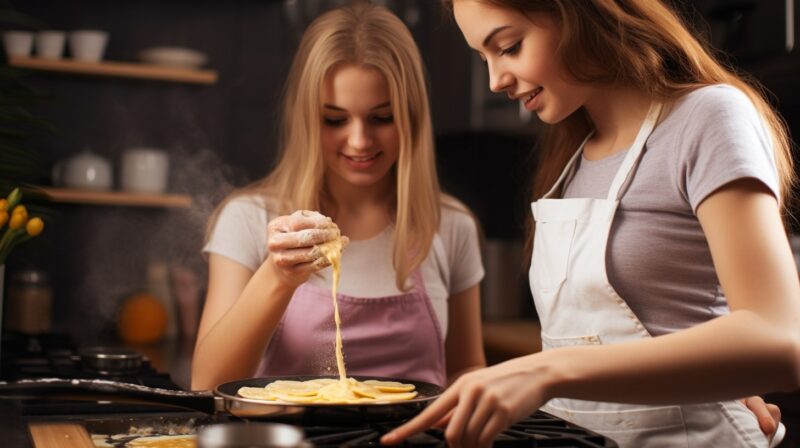
Heating the Pan
The key to perfectly cooked pancakes is a well-heated pan. Heat your pan over medium heat until it’s hot enough that a drop of water sizzles upon contact. If the water evaporates immediately, the pan is too hot, which can cause the pancakes to burn on the outside before they’re cooked through on the inside.
If the water sits without sizzling, the pan is not hot enough, which can result in pale, undercooked pancakes. Once the pan is properly heated, lightly grease it with butter or oil. This will prevent the pancakes from sticking and give them a nice, golden-brown color.
If you’re using a non-stick pan, you may not need to grease it, but a little bit of butter or oil can still add flavor and help achieve a beautiful color.
Pouring and Flipping the Pancakes
Pour the batter onto the hot pan, using about 1/4 cup of batter for each pancake. This will yield pancakes that are about 4 inches in diameter, which is a good size for flipping. If you prefer larger or smaller pancakes, adjust the amount of batter accordingly.
Allow the pancake to cook until bubbles form on the surface and the edges start to look set. This is your cue to flip the pancake. Flipping too early can result in a mess, as the uncooked batter can spill out while flipping too late can result in overcooked, dry pancakes.
Flip the pancake gently with a spatula and cook for another 1-2 minutes, or until the other side is golden brown. Remember, pancakes should be cooked slowly over medium heat to ensure they cook evenly and don’t burn.
Serving the Pancakes
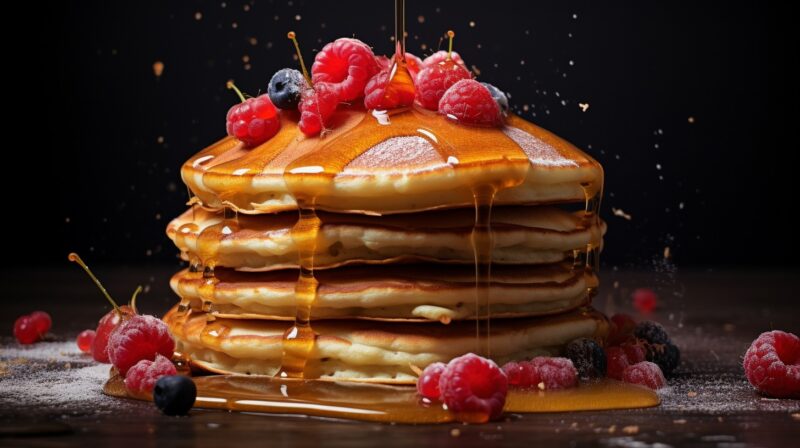
Choosing the Toppings
The toppings you choose can take your pancakes to the next level. Traditional toppings include butter and maple syrup, but don’t be afraid to get creative. Try adding fresh fruits, whipped cream, nuts, or even a sprinkle of powdered sugar.
You can also experiment with flavored syrups, like blueberry or strawberry, for an extra burst of flavor. The flavor of your muffin mix can guide your choice of toppings.
For example, blueberry muffin mix pancakes would pair well with fresh blueberries and a dollop of Greek yogurt, while chocolate chip muffin mix pancakes would be delicious with sliced bananas and a drizzle of chocolate sauce. The possibilities are endless, so feel free to experiment and find your favorite combination.
Presentation is Key
The presentation of your pancakes can make them even more appealing. Stack your pancakes high on a plate and generously drizzle them with your chosen toppings. For a touch of elegance, add a mint leaf or a sprinkle of powdered sugar on top.
You can also arrange the pancakes in a pattern or shape, like a flower or a heart, for a fun and creative presentation. Never forget that we eat with our eyes first, so take a moment to make your pancakes look as good as they taste.
Whether you’re serving them to your family on a lazy Sunday morning or to guests at a brunch party, beautifully presented pancakes are sure to impress.
FAQs:
Can I use water instead of milk?
While you can use water, using milk will provide a richer flavor and better texture to the pancakes.
Are these pancakes suitable for freezing and reheating later?
Yes, you can freeze them in an airtight container and reheat them when needed.
Should I use butter or oil?
Both butter and oil work well, but butter adds a rich flavor to the pancakes.
Do I need to let the batter rest before cooking?
Letting the batter rest for a few minutes can help improve the texture, but it’s not essential.
Can I use a pancake mix instead of a muffin mix for this recipe?
Yes, you can use a pancake mix if you don’t have a muffin mix available.
The bottom line
Making pancakes with muffin mix is a fun and easy way to add a twist to your regular recipe. Not only does it save you time and effort, but it also allows you to experiment with different flavors.
While experimenting with different pancake recipes, I’ve also discovered the art of reheating them to perfection, ensuring they remain as delightful as when freshly made.
So next time you’re in the mood for pancakes, why not give it a try? You might just discover your new favorite breakfast dish, just like I did! – –

